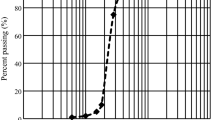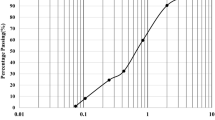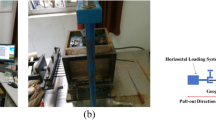Abstract
In this study, an original application called as sanding, which is based on the coating of conventional geogrids with the help of granular soil material and synthetic resin, is proposed to enhance the soil geogrid interaction by the way of improvement of surface roughness. For this purpose, the series of pullout tests performed on geogrids whose smooth surfaces have been roughened by three type of sanding material (fine, medium, and coarse) under three levels of axial load, to investigate the stripping resistance inside poorly graded sand and well graded sand. Extruded and woven types of conventional geogrids were used as in sanded and ordinary forms. According to the results, it has been proven that two-folded increase levels can be achieved in pullout capacity thanks to the sanding technique, while the grain size of the sanding material is the most important parameter used to prevent stripping. Although, sanded extrude specimens showed more ductile and stronger behavior in terms of tensile strength and related strain, woven specimens were negatively affected due to excessive stress formation in the jaw region of test equipment. Therefore, sanding technique can be preferred within the aim of improve the soil–geogrid surface interaction and increase the pullout resistance of geogrids rather than tensile strength required areas. As a result, the design length of usual geogrids can be shortened in critical sections of projects by this way.










Similar content being viewed by others
Data Availability
All data generated or analyzed during this study are included in this published article. Further data will be made available on reasonable request.
References
Patra CR, Das BM, Atalar C (2005) Bearing capacity of embedded strip foundation on geogrid-reinforced sand. Geotext Geomembranes 23:454–462. https://doi.org/10.1016/j.geotexmem.2005.02.001
Yang G, Zhang B, Lv P, Zhou Q (2009) Behaviour of geogrid reinforced soil retaining wall with concrete-rigid facing. Geotext Geomembranes 27:350–356. https://doi.org/10.1016/j.geotexmem.2009.03.001
Álvarez-Mozos J, Abad E, Giménez R et al (2014) Evaluation of erosion control geotextiles on steep slopes. Part 1: effects on runoff and soil loss. CATENA 118:168–178. https://doi.org/10.1016/j.catena.2013.05.018
Esmaeili M, Naderi B, Neyestanaki HK, Khodaverdian A (2018) Investigating the effect of geogrid on stabilization of high railway embankments. Soils Found 58:319–332. https://doi.org/10.1016/j.sandf.2018.02.005
Lees AS, Clausen J (2020) The strength envelope of granular soil stabilised by multi-axial geogrid in large triaxial tests. Can Geotech J 57:448–452. https://doi.org/10.1139/cgj-2019-0036
Das BM (2016) Use of geogrid in the construction of railroads. Innov Infrastruct Solut 1:15. https://doi.org/10.1007/s41062-016-0017-8
Evirgen B, Buyuk B, Cil GT, Deger T (2021) Experimental performance of polyester-fiber-based soil geogrids against reflective cracks. Transp Res Rec 2675:53–64. https://doi.org/10.1177/03611981211027557
Ghazavi M, Ghaffari J (2013) Experimental investigation of time-dependent effect on shear strength parameters of sand-geotextile interface. IJST Trans Civ Eng 37:97–109
Hatami K, Esmaili D (2015) Unsaturated soil – woven geotextile interface strength properties from small-scale pullout and interface tests. Geosynth Int 22:161–172
Ingold TS (1983) Laboratory pull-out testing of grid reinforcements in sand. Geotech Test J 6:101–111
Palmeira EM, Milligan GWE (1990) Scale and other factors affecting the results of pull-out tests of grids buried in sand. Geotechnique 40:519–521
Yogarajah I, Yeo KC (1994) Finite element modeling of pull-out tests with load and strain measurements. Geotext Geomembr 13:43–54
Lopes ML, Ladeira M (1996) Role of specimen geometry, soil height and sleeve length on the pull-out behaviour of geogrids. Geosynth Int 3:701–719
Ochiai H, Otani J, Hayashic S, Hirai T (1996) The pull-out resistance of geogrids in reinforced soil. Geotext Geomembr 14:19–42
Teixeira SHC, Bueno BS, Zornberg JG (2007) Pullout resistance of individual longitudinal and transverse geogrid ribs. J Geotech Geoenviron Eng 133:37–50. https://doi.org/10.1061/(ASCE)1090-0241(2007)133:1(37)
Liu CN, Zornberg JG, Chen TC et al (2009) Behavior of geogrid-sand interface in direct shear mode. J Geotech Geoenviron Eng 135:1863–1871. https://doi.org/10.1061/(asce)gt.1943-5606.0000150
Abdi MR, Zandieh AR (2014) Experimental and numerical analysis of large scale pull out tests conducted on clays reinforced with geogrids encapsulated with coarse material. Geotext Geomembr 42:494–504. https://doi.org/10.1016/j.geotexmem.2014.07.008
Abdi MR, Mirzaeifar H (2017) Experimental and PIV evaluation of grain size and distribution on soil–geogrid interactions in pullout test. Soils Found 57:1045–1058. https://doi.org/10.1016/j.sandf.2017.08.030
Han B, Ling J, Shu X et al (2018) Laboratory investigation of particle size effects on the shear behavior of aggregate-geogrid interface. Constr Build Mater 158:1015–1025. https://doi.org/10.1016/j.conbuildmat.2017.10.045
Attache S, Mellas M (2020) Numerical study of large-scale pull-out test of horizontal corrugated strips. Int J Geotech Eng 14:62–70. https://doi.org/10.1080/19386362.2017.1404201
Chang DT, Rung F (1996) Laboratory study and numerical analysis for pull-out behaviors of geogrids confined by weathered mudstone and sandy soil. Geosynth Appl Des Constr. pp 217–224
Chang DT, Sun T, Hung F (1995) Pullout mechanism of geogrids under confinement by sandy and clayey soils. Transp Res Rec. pp 64–72
Moraci N, Recalcati P (2006) Factors affecting the pullout behaviour of extruded geogrids embedded in a compacted granular soil. Geotext Geomembr 24:220–242. https://doi.org/10.1016/j.geotexmem.2006.03.001
Sert T, Akpınar MV (2012) Investigation of geogrid aperture size effects on subbase- subgrade stabilizatıon of asphalt pavements. Balt J Road Bridg Eng 7:160–168. https://doi.org/10.3846/bjrbe.2012.22
Chen C, Mcdowell GR, Thom NH (2014) Investigating geogrid-reinforced ballast: experimental pull-out tests and discrete element modelling. Soils Found 54:1–11. https://doi.org/10.1016/j.sandf.2013.12.001
Vieira CS, Pereira P, Ferreira F, Lopes ML (2020) Pullout behaviour of geogrids embedded in a recycled construction and demolition material. Effects of specimen size and displacement rate. Sustainability 12:3825
Mosallanezhad M, Taghavi SHS, Hataf N, Alfaro MC (2016) Experimental and numerical studies of the performance of the new reinforcement system under pull-out conditions. Geotext Geomembr 44:70–80. https://doi.org/10.1016/j.geotexmem.2015.07.006
Mosallanezhad M, Alfaro MC, Hataf N, Taghavi SHS (2016) Performance of the new reinforcement system in the increase of shear strength of typical geogrid interface with soil. Geotext Geomembranes 44:457–462. https://doi.org/10.1016/j.geotexmem.2015.07.005
Sadat Taghavi SH, Mosallanezhad M (2017) Experimental analysis of large-scale pullout tests conducted on polyester anchored geogrid reinforcement systems. Can Geotech J 54:621–630. https://doi.org/10.1139/cgj-2016-0365
Mirzaalimohammadi A, Ghazavi M, Roustaei M, Lajevardi SH (2019) Pullout response of strengthened geosynthetic interacting with fine sand. Geotext Geomembranes 47:530–541. https://doi.org/10.1016/j.geotexmem.2019.02.006
Pant A, Datta M, Ramana GV, Bansal D (2019) Measurement of role of transverse and longitudinal members on pullout resistance of PET geogrid. Measurement 148:106944. https://doi.org/10.1016/j.measurement.2019.106944
Brown RE (1977) Vibroflotation compaction of cohesionless soils. J Geotech Eng Div 103:1437–1451
Ahmed KF, Sultana T, Abedin MZ, Farzana K (2022) Suitability number, fineness modulus, density, and strength parameter relations of sandy soil. Advances in civil engineering. Springer, Singapore, pp 91–98
Moraci N, Romano G, Montanelli F (2004) Factors affecting the interface apparent coefficient of friction mobilised in pullout conditions. In: DGGT, TUM-ZG Third European Geosynthetics Conference. pp 313–318
Chen J-F, Gu Z-A, Rajesh S, Yu S-B (2021) Pullout behavior of triaxial geogrid embedded in a transparent soil. Int J Geomech 21:04021003. https://doi.org/10.1061/(asce)gm.1943-5622.0001936
Farrag K, Acar YB, Juran I (1993) Pull-out resistance of geogrid reinforcements. Geotext Geomembr 12:133–159. https://doi.org/10.1016/0266-1144(93)90003-7
Tognon AR, Rowe RK, Brachman RWI (1999) Evaluation of side wall friction for a buried pipe testing facility. Geotext Geomembr 17:193–212. https://doi.org/10.1016/S0266-1144(99)00004-7
Lombardi D, Bhattacharya S, Scarpa F, Bianchi M (2015) Dynamic response of a geotechnical rigid model container with absorbing boundaries. Soil Dyn Earthq Eng 69:46–56. https://doi.org/10.1016/j.soildyn.2014.09.008
Alfaro MC, Miura N, Bergado DT (1995) Soil-geogrid reinforcement interaction by pullout and direct shear tests
Raju DM, Fannin RJ (1997) Monotonic and cyclic pull-out resistance of geogrids. Geotechnique 47:331–337
Sugimoto M, Alagiyawanna AMN, Kadoguchi K (2001) Influence of rigid and flexible face on geogrid pullout tests. Geotext Geomembr 19:257–277
Umashankar B, Chennarapu H, Mouli S (2015) Interface properties of metal-grid and geogrid reinforcements with sand. IFCEE 2015:1430–1438
Sadeghi J, Reza A, Kian T et al (2020) Effectiveness of geogrid reinforcement in improvement of mechanical behavior of sand-contaminated ballast. Geotext Geomembr 48:768–779. https://doi.org/10.1016/j.geotexmem.2020.05.007
ASTM D6706 (2021) Standard test method for measuring geosynthetic pullout resistance in soil. Am Soc Test Mater Int. https://doi.org/10.1520/D6706-01R13
Subaida EA, Chandrakaran S, Sankar N (2008) Experimental investigations on tensile and pullout behaviour of woven coir geotextiles. Geotext Geomembr 26:384–392. https://doi.org/10.1016/j.geotexmem.2008.02.005
TS EN ISO 10319 (2015) Geosynthetics - Wide-width tensile test
Güleç E, Evirgen B (2023) A scale effect on the geogrids produced with three-dimensional printer technology. J Fac Eng Arch Gazi Univ. https://doi.org/10.17341/gazimmfd.909508
Abdi MR, Mirzaeifar H, Asgardun Y (2022) Novel soil-pegged geogrid (PG) interactions in pull-out loading conditions. Geotext Geomembr 50:764–778. https://doi.org/10.1016/j.geotexmem.2022.04.001
Acknowledgements
This study was supported by the Scientific and Technological Research Council of Turkey (TUBITAK) project 2209-B and Eskisehir Technical University project ESTU209. The authors give special thanks to the Istanbul Technical Corporation for industrial collaboration as a consultant company, and their support in terms of material supply.
Funding
Türkiye Bilimsel ve Teknolojik Araştırma Kurumu, Eskişehir Teknik Üniversitesi.
Author information
Authors and Affiliations
Corresponding author
Ethics declarations
Conflict of Interest
The authors have no competing interests to declare that are relevant to the content of this article.
Additional information
Publisher's Note
Springer Nature remains neutral with regard to jurisdictional claims in published maps and institutional affiliations.
Rights and permissions
Springer Nature or its licensor (e.g. a society or other partner) holds exclusive rights to this article under a publishing agreement with the author(s) or other rightsholder(s); author self-archiving of the accepted manuscript version of this article is solely governed by the terms of such publishing agreement and applicable law.
About this article
Cite this article
Tos, M., Ozbakan, N. & Evirgen, B. A Sanding Technique to Improve the Pullout Behavior of Geogrids. Int. J. of Geosynth. and Ground Eng. 9, 72 (2023). https://doi.org/10.1007/s40891-023-00494-3
Received:
Accepted:
Published:
DOI: https://doi.org/10.1007/s40891-023-00494-3




